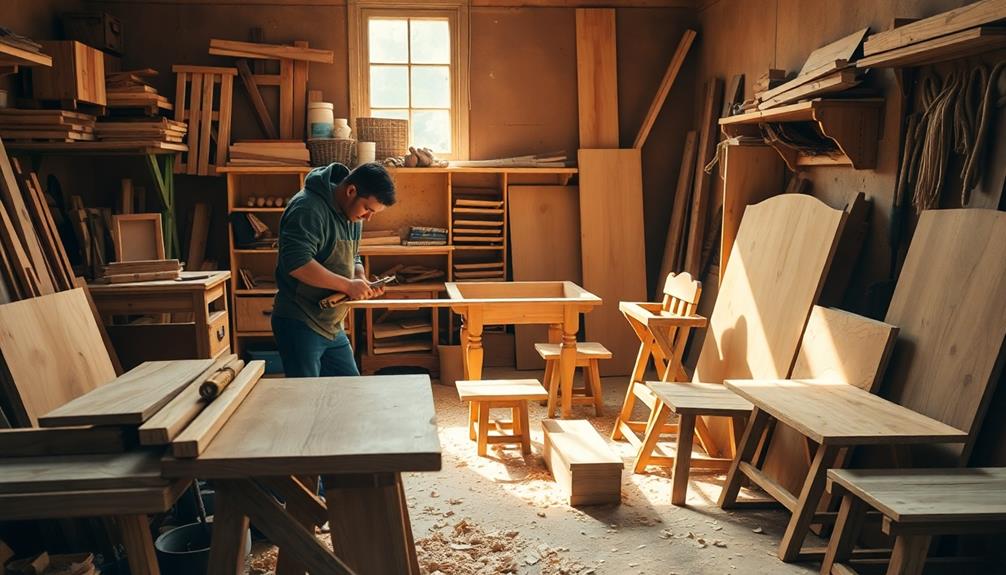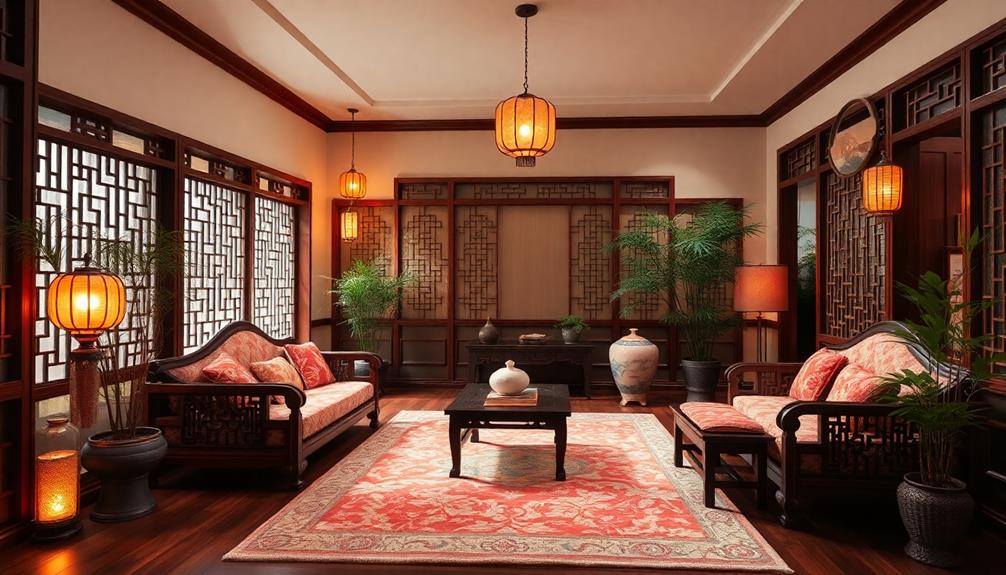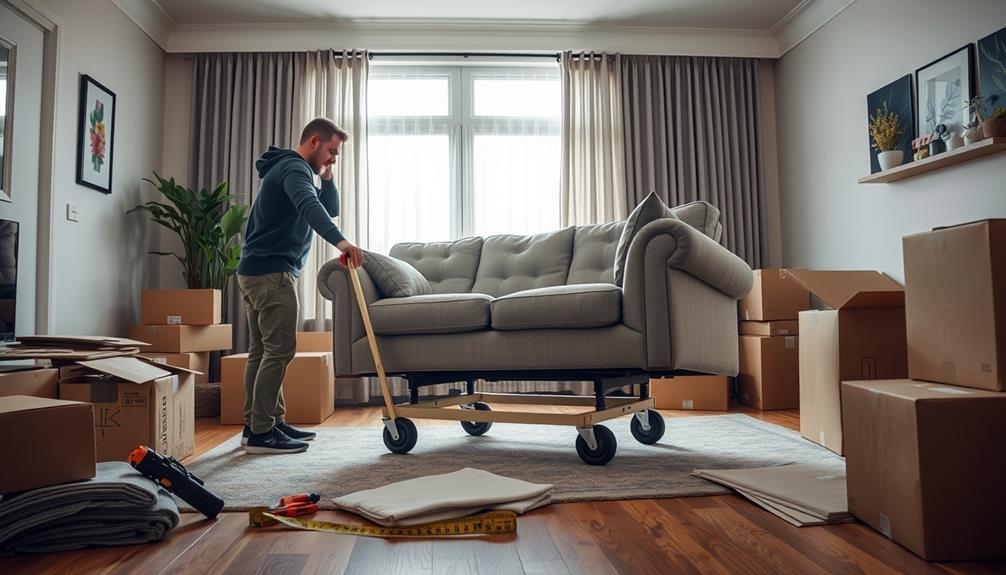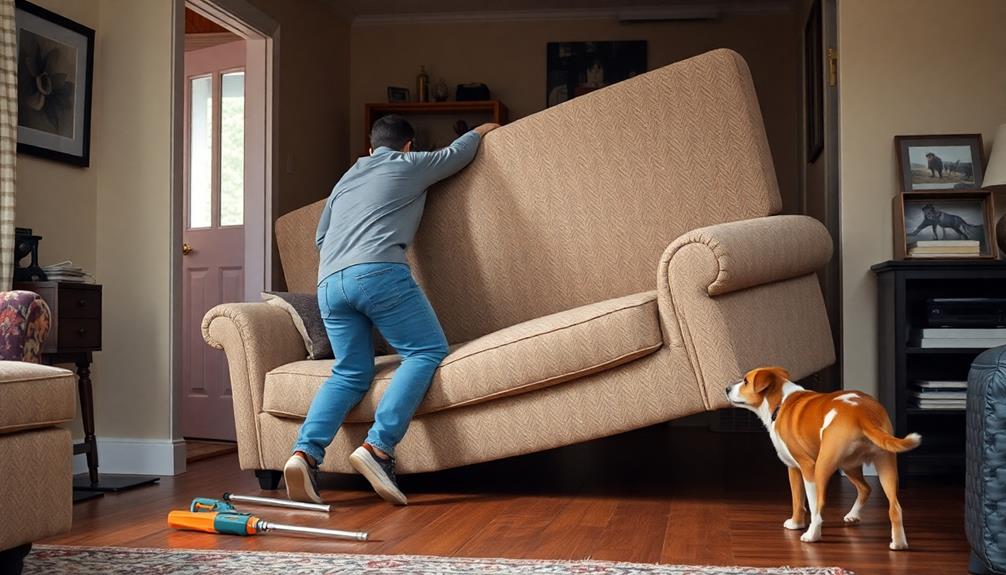You can craft beautiful furniture by starting with a solid blueprint. Draft your design, choose the appropriate materials such as durable hardwoods or cost-effective softwoods, and create a detailed list of cuts. Acquire essential tools, making sure you have a circular saw and power sander for precise cuts. When cutting, be sure to measure carefully. Assemble your pieces using glue and sturdy joints for durability. Don’t overlook finishing details like stains or varnishes for a refined appearance. Interested in discovering more tips and techniques to enhance your furniture-making abilities? There are plenty of useful insights waiting for you!
Key Takeaways
- Plan your project by outlining dimensions, materials, joinery, and finishes to ensure a clear design vision.
- Select appropriate materials, choosing between hardwoods for durability or softwoods for cost-effectiveness, based on your furniture's purpose.
- Utilize essential tools like a circular saw, miter saw, and power sander for accurate cutting and assembly of components.
- Employ proper joinery methods, such as mortise and tenon or pocket hole joinery, to enhance the structural integrity of your furniture.
- Finish your project with stains and sealants, allowing adequate drying time to achieve a durable and visually appealing surface.
Project Planning
When you commence on a furniture project, effective project planning is essential for a successful outcome. Start by creating a detailed plan that outlines dimensions, fixtures, joinery, and finishes. This roadmap will help you execute your vision efficiently, minimizing common mistakes.
Contemplate how different brewing methods can enhance your coffee experience while you work, making your project more enjoyable. Use hand-drawing or software like Sketchup to sketch your designs, giving you a clear visualization of the final product. This can help you adjust your plans before you cut materials to size.
Next, prepare a cut list to accurately estimate material costs. It's wise to add an extra 30% to your budget for potential errors during the cutting process.
Before you glue anything, conduct a dry assembly of all components. This step verifies proper fit and alignment, ensuring everything is in its correct position.
Don't forget to contemplate the purpose of your furniture—whether it's functional, decorative, or both. Your skill level will also dictate the complexity of the techniques you employ in your furniture making.
With a solid plan in place, you'll set yourself up for a smoother and more enjoyable crafting experience.
Material Selection
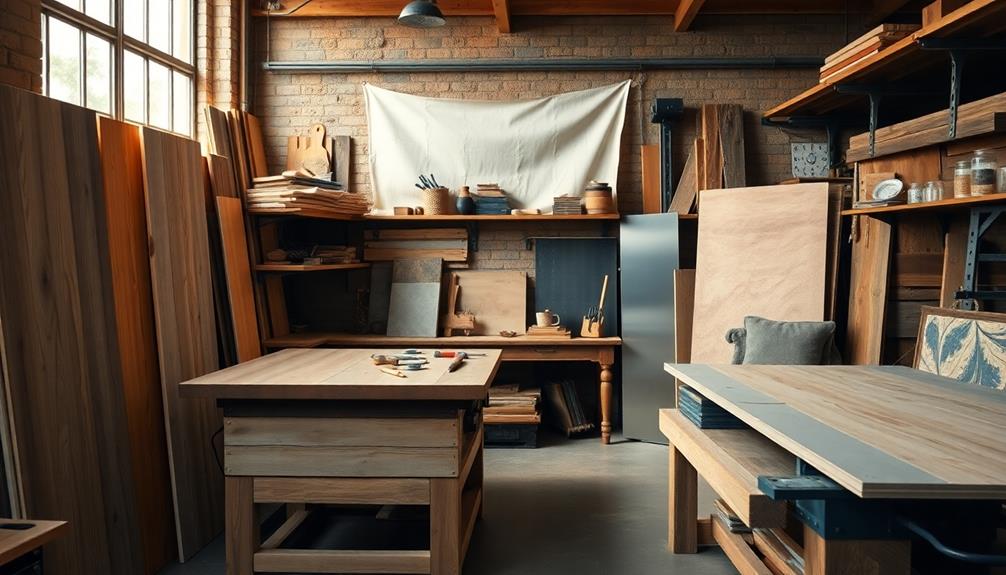
When you're selecting materials for your furniture project, it's essential to take into account the type of lumber you want to use.
For instance, understanding the financial implications of your choices can be beneficial, especially if you're working within a budget financial considerations for elderly care.
Make certain the wood not only fits your aesthetic but also works with the hardware you've chosen and stays within your budget.
Balancing these factors will help guarantee your furniture is both functional and beautiful.
Lumber Type Considerations
Selecting the right lumber for your furniture project can greatly influence both its durability and aesthetic appeal. The type of wood you choose should align with the intended function of your piece of furniture. Hardwoods like oak, maple, and cherry offer strength and beauty, making them ideal for sturdy items like tables and cabinets. On the other hand, softwoods such as pine and cedar are more budget-friendly and easier to handle, perfect for beginners and lighter decorative pieces.
Consider the moisture resistance of different wood types as well. For instance, cedar's natural rot resistance makes it excellent for outdoor furniture. Additionally, the grain pattern and color can elevate your furniture's visual interest; walnut, for example, is known for its rich hues and unique designs.
Here's a quick comparison of wood types:
| Wood Type | Durability | Aesthetic Appeal |
|---|---|---|
| Hardwoods | High | Rich grain |
| Softwoods | Moderate | Simple grain |
| Cedar | High (outdoor) | Warm color |
Hardware Compatibility
Choosing the right hardware for your furniture project is essential for both functionality and aesthetics. Start by verifying hardware compatibility with the type of wood you're using. Different materials can affect durability and appearance, so select screws, hinges, and drawer slides that match your wood choice.
Additionally, consider how the choice of materials can impact the longevity of your furniture, much like the importance of fuel injection cleaning for vehicle performance.
Next, consider the weight and load-bearing capacity of the hardware. For example, if you're building a heavy cabinet, choose robust hinges and slides that can handle the load. Always check the manufacturer's specifications for recommended hardware sizes and types to confirm proper installation and functionality.
Don't overlook the visual appeal; match the finish of your hardware—like polished brass or matte black—with the overall design style of your piece. This cohesion enhances the overall look of your furniture.
If you're working on outdoor furniture, opt for corrosion-resistant materials such as stainless steel to withstand moisture and environmental elements.
Budget Constraints
Budgeting for your furniture project is essential, especially when it comes to material selection. You can save a significant amount by opting for less expensive softwoods like pine instead of pricier hardwoods such as oak or maple. This choice can cut your material expenses by 30-50%.
Additionally, consider sourcing reclaimed wood or secondhand furniture; you'll often find quality materials at a fraction of the cost, sometimes saving over 70%.
MDF and plywood are also great alternatives for certain projects, typically costing 50% less than solid wood for similar-sized pieces. Don't forget to take advantage of sales and discounts at local lumber yards or home improvement stores. Bulk purchases or seasonal sales can yield savings of 10-30%.
To keep your project on track financially, create a detailed budget and prepare a cut list. This list should include estimated material costs and an additional 30% buffer for mistakes or adjustments.
Essential Tools
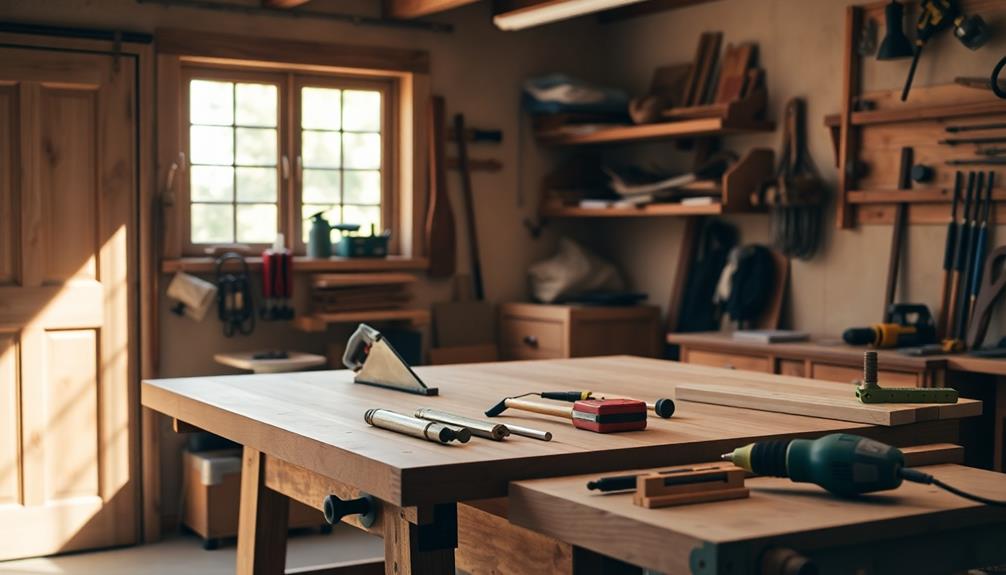
When you start making furniture, having the right tools is key to your success.
Essential power tools like a circular saw and drill will make your projects easier and more efficient.
You might also consider optional tools that can enhance your work and improve the final product.
Basic Power Tools
Having the right tools is essential for any furniture-making project, and basic power tools form the backbone of your workshop.
Start with a circular saw; it's perfect for making long, straight cuts in lumber and can handle various thicknesses of wood. For precise angled cuts, a miter saw is a must-have. It's especially useful for creating frames and trim pieces with clean edges.
A power sander, like a random orbital sander, greatly reduces manual sanding time while smoothing surfaces and preparing wood for finishing. This tool helps you achieve a professional look without the extra effort.
Additionally, invest in a Kreg Pocket Hole Jig; it simplifies the joinery process by allowing you to create strong, hidden joints, making assembly easier and more efficient.
Optional Tools Enhancements
While basic power tools are essential for furniture making, optional tools can greatly enhance your projects. Investing in a table saw can markedly boost your cutting efficiency and accuracy, especially for more complex designs.
If you often work on-site, a portable jobsite table saw offers the versatility you need for easy transportation and setup.
Another valuable tool is a band saw, which allows you to make intricate cuts and curves. This capability opens up a wider range of furniture design possibilities, making your pieces stand out.
Don't overlook the importance of a thickness planer as well. It helps achieve uniform thickness across boards, ensuring your final furniture has a polished and professional appearance.
Additionally, consider incorporating a dust collection system into your workspace. This will minimize debris and promote safety during cutting and sanding operations, making your environment more pleasant and efficient.
Cutting Techniques
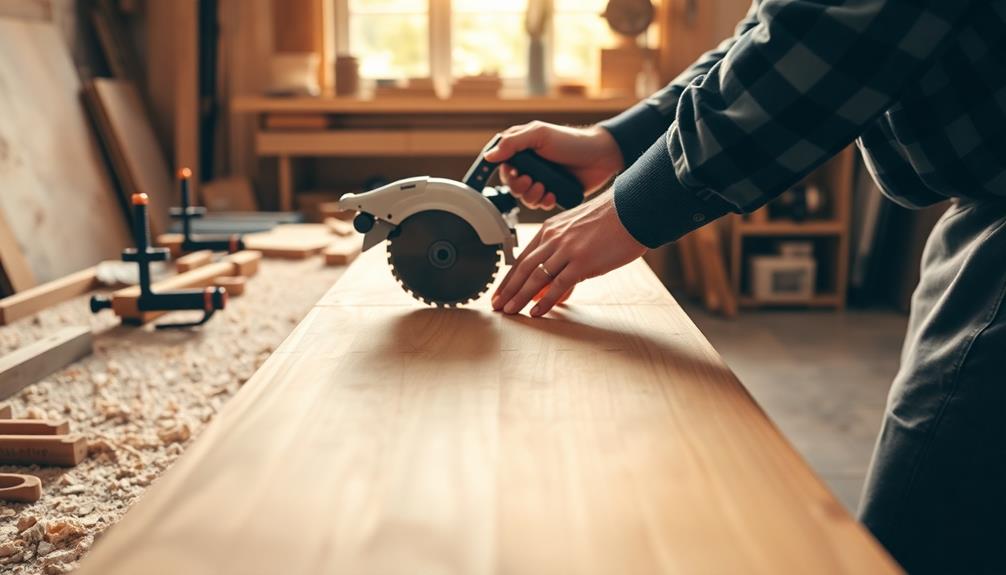
Cutting techniques are vital to achieving a precise and professional finish in your furniture-making projects. Start by properly milling your lumber to guarantee it's flat and at the desired thickness. This step is essential for uniformity in your finished piece. When you cut one or more pieces of plywood, using jigs or guides helps maintain precision, resulting in consistent lengths and widths.
Here's a quick reference table for effective cutting techniques:
| Technique | Description | Tool Suggestions |
|---|---|---|
| Milling | Flatten and size your lumber | Planer, Jointer |
| Marking | Clearly mark dimensions with chalk | Chalk, Measuring Tape |
| Guiding | Use jigs or guides for accuracy | Circular Saw, Miter Saw |
| Measuring | Measure multiple times to guarantee accuracy | Tape Measure |
Always measure multiple times and double-check your cuts to avoid mistakes. Minor discrepancies can greatly affect your final assembly and appearance. By following these techniques, you'll set a solid foundation for your furniture-making journey.
Assembly Process
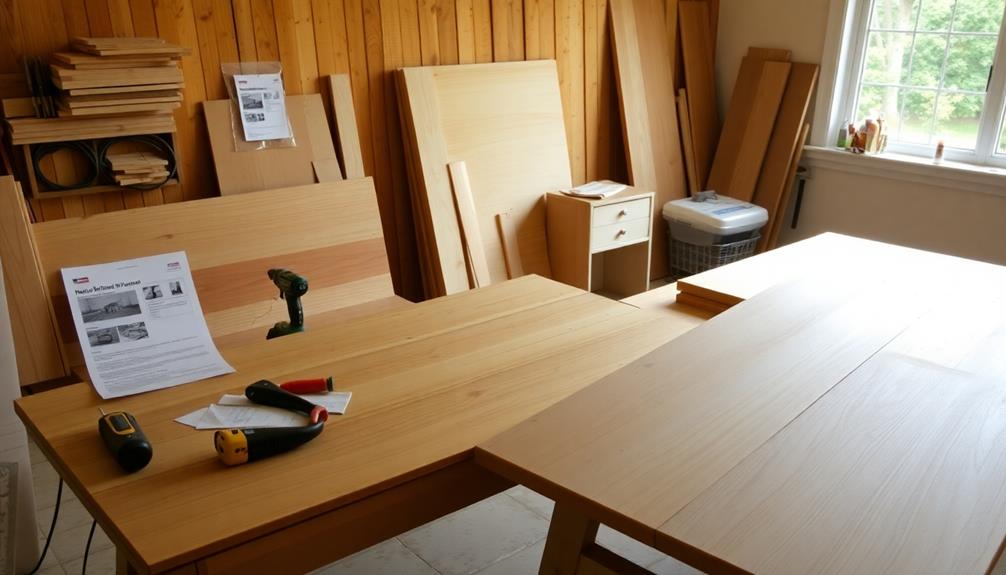
The assembly process is essential for bringing your furniture project to life, and starting off organized can make all the difference. Before diving in, take a moment to gather all parts and hardware. This step streamlines your workflow and reduces confusion, guaranteeing that you can focus on crafting one piece at a time.
Here's a quick checklist to keep you on track:
- Organize parts and hardware by type.
- Perform a dry fit of all components.
- Use appropriate adhesives, like wood glue.
- Clamp parts securely during the drying phase.
- Regularly check for square and alignment.
Once you've got everything laid out, do a dry fit to guarantee proper alignment and fit. This way, you can catch any issues before applying adhesives or fasteners.
When it's time to assemble, use wood glue along with screws or nails to enhance the structural integrity, making your furniture stable and durable. Don't forget to clamp parts securely to maintain alignment while the adhesive cures.
Throughout the assembly process, consistently check for square and alignment to guarantee your finished piece is both sturdy and visually appealing.
Joinery Methods
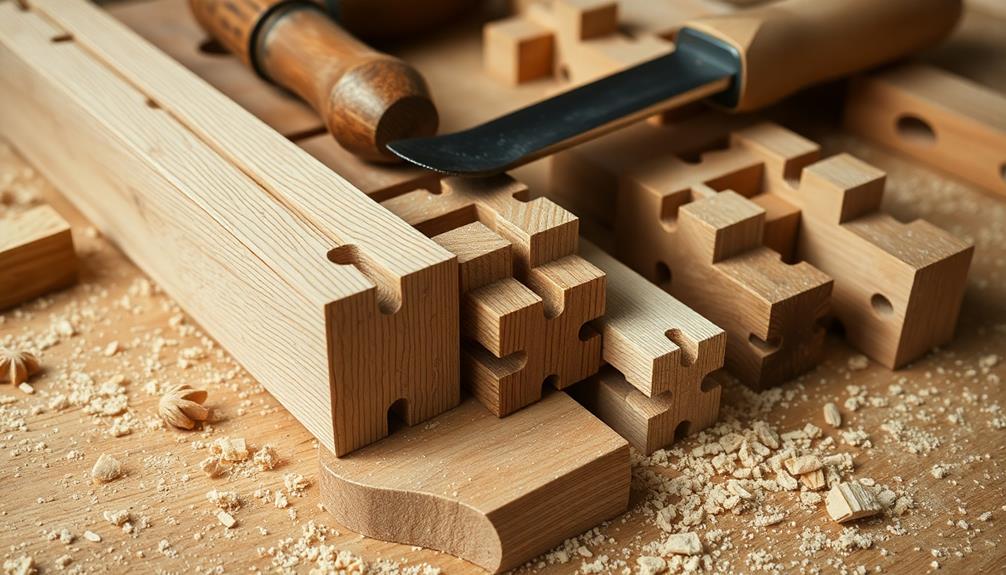
After successfully assembling your furniture pieces, the next key step involves selecting the right joinery methods to connect them securely. The method you choose can greatly impact the strength and appearance of your furniture.
One of the most traditional and robust techniques is the mortise and tenon joint. This method involves creating a cavity (the mortise) in one piece of wood and a corresponding projection (the tenon) on the other. It's especially effective in frame construction, providing a strong and reliable connection.
Another popular joinery method is the dovetail joint, known for its interlocking shapes. You'll often find this technique in drawer construction, as it resists being pulled apart while adding a touch of visual appeal.
For those looking for a modern approach, pocket hole joinery is a fantastic option. It uses angled holes to connect pieces with screws, allowing for quick assembly and a cleaner look without visible fasteners.
Whichever joinery methods you choose, remember that well-executed techniques enhance your furniture's durability and longevity, making this decision a vital part of your project.
Finishing Techniques
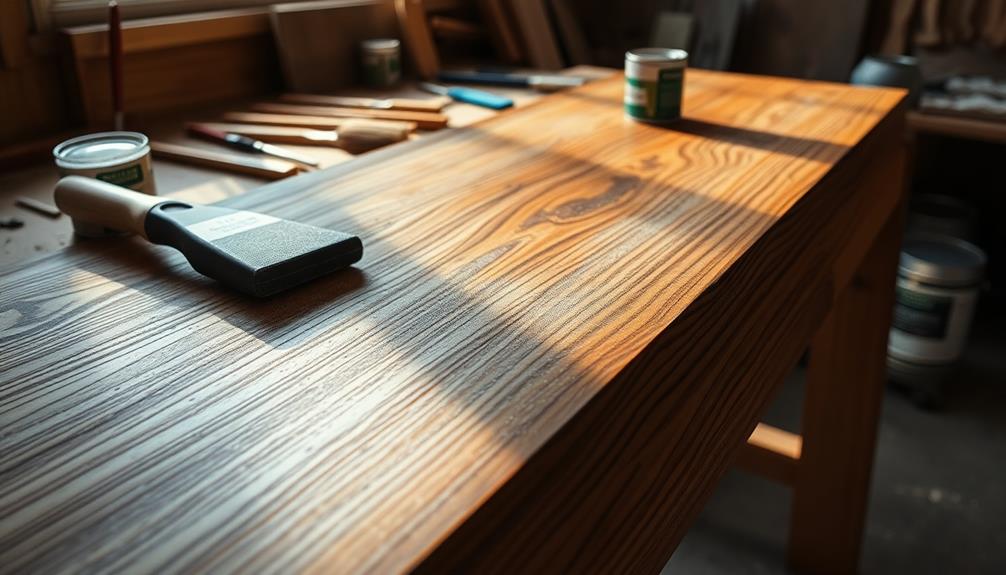
Although finishing techniques may seem secondary to construction, they play an essential role in enhancing both the appearance and durability of your furniture. To achieve a professional look, follow these key steps:
- Always test stains or dyes on scrap wood to preview results.
- Seal blotchy woods, like Cherry, with a 1/2 lb cut of shellac before staining.
- For a durable finish, mix 1/3 Boiled Linseed Oil, 1/3 Polyurethane, and 1/3 Mineral Spirits.
- Allow at least 24 hours of drying time between coats of varnish.
- Inspect surfaces for imperfections after finishing for the best results.
When you apply a coat of paint, remember that even minor defects can impact the final look. Sand between coats with finer grits (320, 400, 500) to guarantee a smooth finish.
The right finishing techniques won't only protect your furniture but also highlight the beauty of the wood. By committing to these steps, you'll create pieces that stand the test of time while looking great in any setting.
Safety Precautions
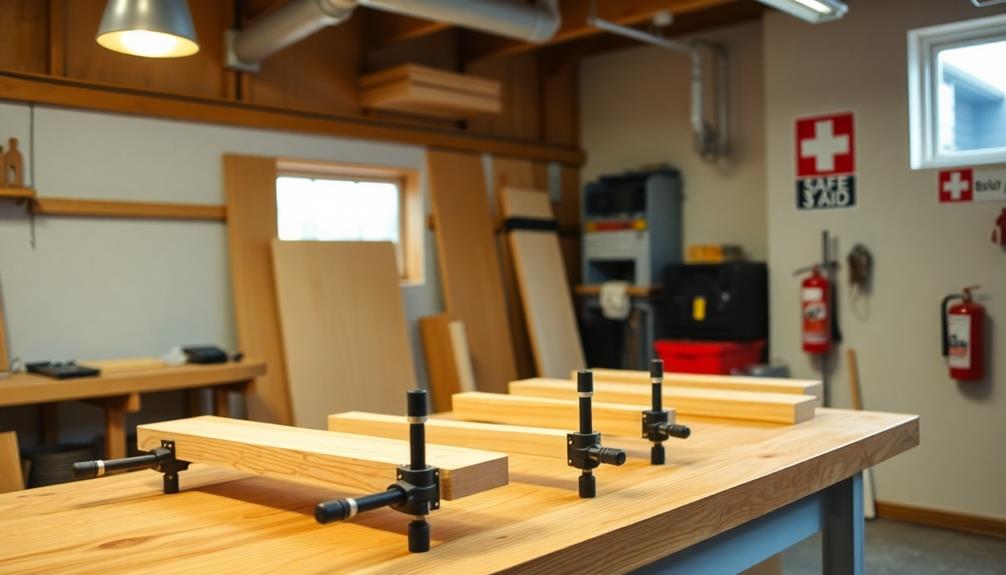
Safety should always be your top priority when making furniture. Always wear safety goggles to protect your eyes from dust and flying debris while cutting or sanding wood. Proper eye protection is vital for preventing injuries that could sideline your project.
When operating power tools, use push sticks and push blocks to keep your hands safely away from blades and bits. This simple practice can save you from serious accidents.
Confirm your workspace is well-lit and clutter-free; good visibility helps prevent mishaps and allows you to focus on your craft.
Having a first aid kit readily accessible is essential. Familiarize yourself with the location of emergency shut-off switches for your tools to quickly respond in case of an accident. Being prepared can make a difference in critical moments.
Lastly, regularly inspect and maintain your tools. Dull or damaged tools can lead to injuries and affect your results. Keeping your tools in good working order guarantees a safer and more enjoyable furniture-making experience.
Customization Options
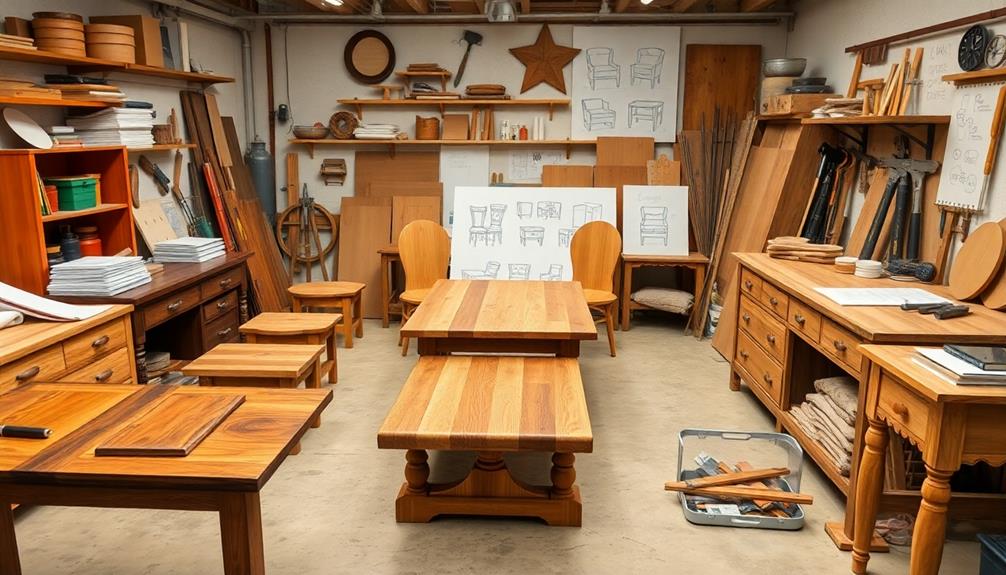
Creating custom furniture allows you to express your personal style while guaranteeing functionality meets your specific needs.
By exploring various customization options, you can design a piece that perfectly fits your home and lifestyle. Here are some ideas to contemplate:
- Wood Types: Choose from a variety of woods like oak, maple, or walnut to complement your decor.
- Finishes and Colors: Select the perfect finish and color to create a unique aesthetic that reflects your taste.
- Functional Features: Incorporate adjustable shelving, hidden compartments, or integrated lighting to enhance usability.
- Personalized Hardware: Opt for unique knobs or handles that give your furniture a distinctive touch.
- Upholstery Choices: Explore different fabric types and patterns for cushions or coverings to guarantee comfort and style.
Frequently Asked Questions
Is It Cheaper to Buy or Build Your Own Furniture?
It's often cheaper to build your own furniture. You'll save considerably compared to store-bought options, enjoy personalized designs, and choose high-quality materials, all while gaining valuable skills and a sense of accomplishment throughout the process.
How to Start Furniture DIY?
"Measure twice, cut once." To start your DIY project, outline your plan, gather materials, and sharpen your tools. Test new techniques on scrap wood, then dry assemble parts for perfect alignment before final assembly.
What Are the Steps in Making Furniture?
To make furniture, you'll select suitable wood, create a cutting plan, assemble pieces using various methods, sand surfaces for smoothness, and finally apply finishes while considering customization for your personal style and functional needs. Additionally, understanding space management is crucial, as arranging bedroom furniture effectively can enhance the flow and comfort of a room. Careful attention to balance, proportion, and the placement of key pieces like the bed and wardrobe ensures both aesthetic appeal and practicality. Ultimately, a well-organized, personalized design can transform a space into a harmonious retreat.
What Is the Easiest Piece of Furniture to Make?
If you're seeking simple solutions, a side table's your best bet. It's straightforward and satisfying, needing minimal materials and tools. You'll find it's an excellent entry point into the enjoyable world of woodworking.
Conclusion
In the end, you've mastered the art of furniture making, and who knew it could be this easy? With just a bit of planning, the right materials, and some tools, you're now a DIY expert—definitely ready to tackle that project you've been putting off. So go ahead, impress your friends with your newfound skills. After all, why buy overpriced furniture when you can spend hours creating something that's just as wobbly? Happy building! Plus, the satisfaction of creating something with your own hands is worth every minute spent sanding and measuring. Next on your list could be to build a sofa table—perfect for showcasing your craftsmanship and adding a personal touch to your living space. Just imagine how great it’ll feel when your guests ask where you got that stylish piece, and you get to say, “I made it!
